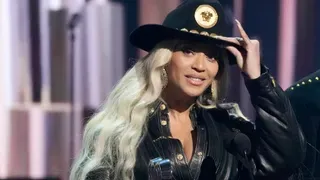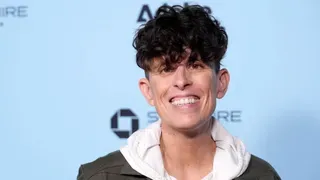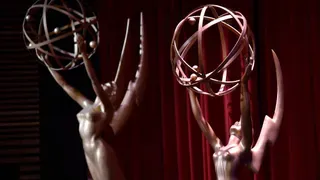November 20, 2024
Approaching its Centenary, Martha Graham Dance Company's Lloyd Knight Addresses Founder's Pioneering Spirit
Nicholas Dussault READ TIME: 10 MIN.
In the world of dance, Martha Graham is truly iconic. Her influence on the art form is still felt today, nearly 100 years after she founded the Martha Graham Studio. Her impact on dance is unparalleled and the incredible list of artists she's worked with includes Rudolf Nureyev, Mikhail Baryshnikov, Margot Fonteyn, Madonna and Liza Minnelli. She has also influenced the work of great choreographers like Twyla Tharp, Merce Cunningham and Paul Taylor.
She has been credited with revolutionizing dance with a new language and new concepts, challenging contemporary social issues and inspiring generations with her bold, politically powerful artistry. She was also the first dancer to ever perform at the White House. Over the course of her career Graham created 181 dance pieces, many of which are still being performed to this day. Her most famous – "Appalachian Spring" – had a score by Aaron Copland, and over the years she worked with a 'who's who' of 20th century composers including Samuel Barber, Carlos Chávez, Gian Carlo Menotti, Alan Hovhaness, John Corigliano, and, late in her career, Igor Stravinsky. Her many accolades include receiving the Presidential Medal of Freedom from Gerald Ford and the National Medal of the Arts. She was a 1979 honoree at the Kennedy Center and Time Magazine named her the "Dancer of the Century." After a bout with depression and alcohol in her 70s, she recovered and returned to choreography, completing her final ballet, "Maple Leaf Rag" with music by Scott Joplin and costumes by Calvin Klein, in 1990 at the age of 95. She died the following year at the age of 96. In 2004 she was featured on a U.S. postage stamp.
Her company has graced some of the greatest stages in the world including Carnegie Hall, the Metropolitan Opera, the Paris Opera House and even the base of the Great Pyramids in Egypt. It's been nearly two decades since they have performed in Boston, but they will be making a special appearance Friday, November 22 and Saturday, November 23 at the Emerson Cutler Majestic Theatre as the first event in the Celebrity Series of Boston's 2024-25 Season Dance Series.
Recently EDGE had the chance to chat about life as a dancer with Lloyd Knight, a Principal Dancer in the Graham Company, as he prepares to return to Boston for the upcoming performances.
EDGE: Let's start with Martha Graham. Why is she still such an important figure in the world of dance?
Lloyd Knight: To the dance world she's a pioneer. She's someone that took dance to another level and opened up the opportunities for being an artist. There was ballet and then she came forward talking about real life topics and emotions. She was risky, barefoot and grounded. She's very raw to me. I get a real feeling of freedom with her work. She showed us all another way. And I think the reason it's lasted this long is that so many people can connect with it. You cannot deny the feeling you have when you watch her work.
EDGE: Would you call her style contemporary?
Lloyd Knight: It probably went through stages, there was one period I remember people were calling it contemporary, but it's known as classic modern dance.
EDGE: Does her work relate to ballet at all?
Lloyd Knight: She wasn't ignoring ballet. It's definitely in the dance form itself. Everything is kind of connected. Some of the dancers she would work with were very classically trained and she would use that to her advantage, taking that form and playing with it, turning it into something she could use in her modern vocabulary.
EDGE: How long have you been dancing?
Lloyd Knight: Professionally, for 19 years and always with Martha Graham.
EDGE: How did you start dancing?
Lloyd Knight: I started in middle school. I went to a magnet performing arts school in Miami. I wasn't in the magnet program at first, I was just a regular student. But my homeroom class was in the dance studio and we would play around, not at all serious about it. One day our teacher invited me to stay after school and try out some moves. And I did. She took me into the program, and that was kind of it.
EDGE: And a dancer was born. Did you envision a career in dance at the time?
Lloyd Knight: I really just wanted to dance but I didn't necessarily know where. Then I met a former Graham principal, Peter London. He introduced me to the Graham Technique and the work and I really got hooked on it. I did summer programs and whatnot, and senior year I auditioned and got in.
EDGE: What does it mean to be a principal in a dance company?
Lloyd Knight: I've gone through the ranks, the journey of the path of a dancer in the Graham Company. When I started off it was just laying the groundwork, doing the core work and learning from the higher ups, the people that came before me. It was a full journey going from core to more soloist opportunities, then taking on real principal roles. And now we do contemporary work as well. It's a good mix. It's been a lot of fun.
EDGE: The life of a dancer seems hard, both physically and emotionally.
Lloyd Knight: It is, especially with work like this where you have to draw from deep within. These topics we're dancing about require us to pull from personal stories to really connect to the characters. And you have to connect as deeply as possible so that it reads out.







